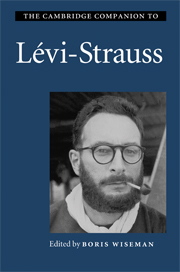Book contents
- Frontmatter
- Introduction
- Part I: Society and culture
- 1 Lévi-Strauss and the question of humanism followed by a letter from Claude Lévi-Strauss
- 2 Lévi-Strauss and history
- 3 Structure and exchange
- 4 The future of the structural theory of kinship
- Part II: Myth and mind
- Part III: Language and alterity
- Part IV: Literature and aesthetics
- Bibliography of works by Claude Lévi-Strauss
- Index
4 - The future of the structural theory of kinship
from Part I: - Society and culture
Published online by Cambridge University Press: 28 January 2010
- Frontmatter
- Introduction
- Part I: Society and culture
- 1 Lévi-Strauss and the question of humanism followed by a letter from Claude Lévi-Strauss
- 2 Lévi-Strauss and history
- 3 Structure and exchange
- 4 The future of the structural theory of kinship
- Part II: Myth and mind
- Part III: Language and alterity
- Part IV: Literature and aesthetics
- Bibliography of works by Claude Lévi-Strauss
- Index
Summary
Since the publication of The Elementary Structures of Kinship (1949a; 1969a), Lévi-Strauss's work on kinship has acquired a somewhat ambiguous status: foundational, of course - a classic - but a classic whose specific thesis and concepts are frequently thought of as having little relevance to today's anthropology. After forming one of the two grand paradigms that polarised the field of kinship studies in mid-twentieth-century anthropology (the 'alliance theory' that became opposed to the 'descent theory' of British extraction) Lévi-Straussian theses (along with descent theory) fell under the fire of critics from culturalist, practice theory and feminist perspectives, among other tendencies that entered the anthropological scene from the seventies onwards - the decade that saw the demise of kinship itself as an anthropological concept, if not as a legitimate subject of anthropological enquiry.
The news of its passing having been perhaps exaggerated, kinship remains a cherished topic of anthropological research. The field has, nevertheless, re-emerged from the fin-de-siècle doubts deeply transformed. Among the multiple aspects involved, the most conspicuous is the status of a conceptual and ideological opposition - that between nature and culture - that is central to Lévi-Straussian kinship theory, to anthropology in general and, more generally still, to modern(ist) thought. A keystone of all of those ideational structures, and of the more material ones we build from them, the dichotomy is today the focus of many of our uncertainties, and the efforts to deconstruct it are perhaps surpassed only by the efforts to reconstitute it - inside and outside anthropology.
- Type
- Chapter
- Information
- The Cambridge Companion to Lévi-Strauss , pp. 80 - 100Publisher: Cambridge University PressPrint publication year: 2009
- 1
- Cited by

